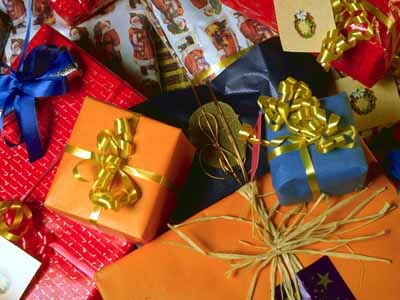tags: researchblogging.org, psychology, gift wrapping, wrapping paper, behavior, holidays, holidaze
Besides bright lights, my favorite thing about the holidays is wrapping gifts. I love covering a boxed gift with colored papers (or even with plain brown paper bags), I get tremendous satisfaction from folding the paper so it makes precise corners and then I especially enjoy decorating the wrapped gift with bows, ribbons and toy flowers and birds, christmas ornaments or other decorations. I also enjoy figuring out how to wrap unusually shaped objects. However, my most favorite thing to do is to place a wrapped gift inside a series of wrapped boxes, so the eventual discovery of the gift inside is postponed for as long as possible. I enjoy wrapping gifts so much that I sometimes think I should open a small business that focuses specifically on doing this.
But what does gift-wrapping do for the recipient? Is all this effort worth it for the recipient? For example, do recipients actually like gift-wrapped presents more than unwrapped gifts?
According to a study that was published 15 years ago by Daniel Howard, professor of marketing at Southern Methodist University in Dallas, it appears so. To test this question, Howard designed a series of experiments to test his basic hypothesis; a gift-wrapped item influences the recipient to have a more favorable attitude towards owning the gift item.
In one experiment, 45 university students were asked to evaluate four products in exchange for a free gift. Even though they thought they were evaluating the four products, they were actually evaluating the free gift they received in return for evaluating the four products.
Their gift? A sheepskin bicycle cover.
In this experiment, half of the subjects received their bicycle cover in the manufacturer's plastic bag, while the other half received it wrapped in blue-and-white paper with a matching ribbon and bow. The subjects were then asked to rate their gift on three nine-point scales, ranging from undesirable to desirable, from bad to good and from foolish to wise. Those test subjects who received the gift wrapped bicycle seat cover gave it a higher overall approval rating (7.14) than those who received it unwrapped (6.06).
In a second experiment, 82 different university students received their bicyle seat cover gift either wrapped or unwrapped. But this time, some students were led to believe that the gift was meant for them while others thought that it was meant for someone else. Those recipients who thought the gift was for them were happier with it when it was wrapped. However, interestingly, those who thought the gift was for someone else didn't care at all whether the gift was wrapped.
Yet another experiment tested whether the perceived "quality" of the wrapping paper itself affected the subjects' attitudes towards the gift. To do this, another 60 university students were given either wrapped, unwrapped or "nontraditionally wrapped" gifts (wrapped in brown packaging paper with neither ribbons nor bows). Perhaps not surprisingly, the nicely wrapped gift was the favorite, while the unwrapped gift was the least favorite. Even the non-traditionally wrapped gift (in plain brown paper) was preferred over the one that was not wrapped at all.
So why do we care about wrapping paper? Answering this question is a little more complicated, but the author argues that gift wrapping is a visual signal that is associated with a happy event in a person's life.
"Gift wrapping, through repeated pairing with joyous events in people's lives, has utility in cuing a happy mood which, in turn, positively biases attitudes," wrote Howard.
"These results are consistent with an encoding specificity view of mood retrieval and a mood maintenance explanation of attitude formation," Howard wrote, somewhat cryptically. "The encoding specificity view was supported by finding stronger effects of gift wrapping on mood retrieval in conditions arguably present when the relation between gift wrapping and happy mood was established in the lives of subjects, such as the receipt of a personal gift [and] the receipt of a gift wrapped in traditional gift-wrapping paper."
The study subjects' positive moods were supported by finding parallel effects of gift wrapping on mood and attitude and by finding the mediational effects of happy mood on attitude strengthened as subjects felt happier. These results are consistent with the premise that the happier one's mood, the more that the one seeks to maintain that state through the development of favorable attitudes toward owning the gift received.
This study was published in the Journal of Consumer Psychology in 1992.
Sources
Daniel J. Howard. Gift-Wrapping Effects on Product Attitudes. (1992). Journal of Consumer Psychology, 1(3):197-223 | doi: 10.1207/s15327663jcp0103_01 [abstract and PDF].


So in short, they think it's a learned emotional reaction. Trouble is, the research you describe only shows that there is a preference, not why! The interpretation (while certainly plausible) doesn't actually follow....
Whoops, never mind, I missed that part. I'd have liked to see more detail about that side of things....
I'm a gift wrapping freak too. I collect ribbon, bows, odd trinkets to use and boxes of all shapes and sizes. I even get my boxes back when I can. I really scored this year - I only lost one box.
I'm not sure why people enjoy well wrapped gifts but I know I do it to show people how special they are to me and I think that's they way they view it.
Thanks, Grrl, for blogging tonight. I've been using my breaks from my shiny new Xbox 360 to check in here and I've really enjoyed the posts from you and your readers. It's been a happy day.
Were the subjects told what the gift was (in the experiments where they believed it was intended for them) before unwrapping it. Before I read your summary of the conclusions, I was thinking that anticipation could be a factor. Maybe another study could test this?